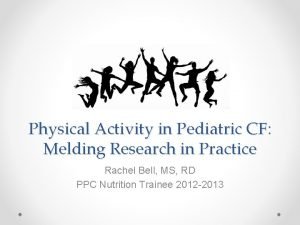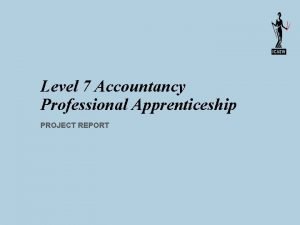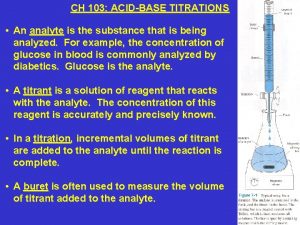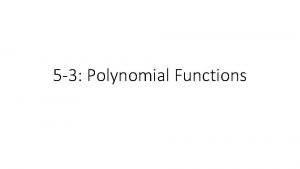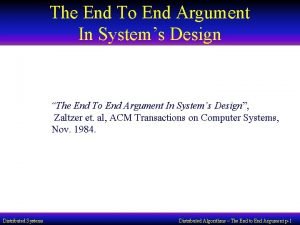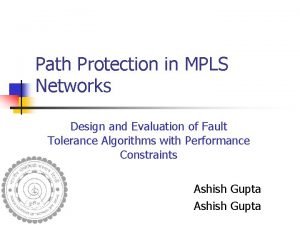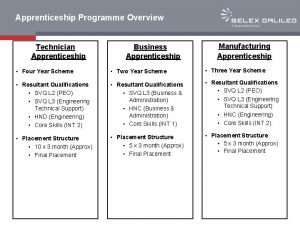Physiotherapist Level 6 Integrated Degree Apprenticeship End Point













- Slides: 13

Physiotherapist Level 6 Integrated Degree Apprenticeship End Point Assessment update

End Point Assessment (EPA) EPA is about End Point NOT on-programme assessment and aims to: • rigorously assess that an apprentice can perform the occupation they have been trained in and meets the duties, knowledge, skills and behaviours set out in the standard • use at least 2 assessment methods that assure consistency • EPA must be: • Valid • Reliable • Manageable • Affordable • Accessible

Apprenticeship structure • Physiotherapy Honours Degree approved by the HCPC and accredited by the CSP is the required underpinning qualification for the physiotherapist integrated level 6 degree apprenticeship • The apprenticeship will comprise a total of 360 credits and conform to university quality assurance requirements for the award of credit at levels 4, 5 and 6. • 340 credits will be dedicated to on-programme training and assessment. The final 20 credits at level 6 of the programme will be dedicated to the EPA.

Physiotherapist Level 6 Integrated Degree Apprenticeship Integrated degree • EPA takes place within the degree programme so that the apprentice completes both the degree and the apprenticeship at the same time. • The university offering both on-programme training and EPA needs to be registered as both an Apprenticeship Training Provider and an End Point Assessment Organisation. • The EPA must still deliver an impartial result, wherever possible the assessor must be from a different organisation.

Apprentice must meet gateway requirements first Evidence of English and Mathematics qualification at a minimum of level 2 as per general apprenticeship requirements. For those with an education, health and care plan or a legacy statement the apprenticeships English and maths minimum requirement is Entry Level 3 and British Sign Language qualification are an alternative to English qualifications for whom this is their primary language Achievement of 340 credits towards the BSc (Hons) in Physiotherapy, including through the successful completion of 1000 hours of assessed clinical practice-based learning Achievement of the knowledge, skills and behaviours in the physiotherapist level 6 integrated degree apprenticeship standard Completion of a portfolio Confirmation from the employer that the requirements of the integrated degree apprenticeship standard have been met within the apprentice’s workplace.

Range of assessment methods Presentation based Observation based Practical demonstration based Test based Project based • EPA is the only interaction the independent assessor has with the apprentice. • They must make a professional judgement about their competence based solely on what happens during EPA. • On-programme performance (eg within their degree or training course) cannot be taken into account at EPA. • At least one of the assessment methods chosen must assess the skills, knowledge and behaviours from the standard synoptically. • Higher level KSBs can be assessed in the EPA that show that lower level KSBs have been met. • Things like reflective accounts and portfolios cannot be used as assessments in their own right, only to underpin other assessment methods eg a portfolio that is generated whilst on programme may be used to inform a professional discussion but only if it is specified in the standard and EPA as a gateway requirement; ie that the apprentice must complete this on-programme before going onto EPA

Assessment methods agreed Method Element 1 Case study Contribution to final grade 50% Duration 15 minute Assessed by EPA independent assessor Element 2 Professional discussion (viva voce) 50% 45 minutes EPA independent assessor

Case study • The apprentice is required to prepare and present an element of practice experience as a case study using digital media and submitted online for assessment – Based on a complex case – Demonstrating clinical reasoning, critical thinking, and decision making – 15 minute • Will be assessed against 2 of the standards domains – Physiotherapy practice – Physiotherapy values and behaviours • Associated detailed grading criteria

Professional discussion • One to one face-to-face professional discussion of 45 minutes duration (+/- 10%) • Based on a portfolio completed before the EPA gateway • Will be synoptic Based on all 4 of the standards domains – Physiotherapy practice – Physiotherapy values and behaviours – Development of self and others – Professional engagement • Associated detailed grading criteria

Developing the EPA - 1 Assessment methods • are required to be mapped to the KSBs • chosen must be discreet from one another • must reflect the level and scope of the role • Must be robust • should vary and not rely on one mode of delivery only.

Developing the EPA - 2 • Affordability – different assessment methods have been considered to ensure value for money. – Technological solutions are included. • Access • Grading – Assessments are graded (e. g. 1 st, 2 ii, 3 rd, fail) fail criteria has to be included. • Consistency – assessment methods and grading must be able to be applied consistently irrespective of where the apprentice is and who the End Point Assessment Organisation is.

Developing the EPA - 3 • Themes – Knowledge, skills and behaviours, are grouped into themes being tested by each method • Weighting – both are of equal importance 50% • Re-sits/Re-takes: – One further opportunity for re-siting/re-taking the assessment is allowed for each element. Any retake(s) of either assessment must be concluded within the six-month period from the apprentice going through the gateway to the EPA, and in accordance with the education provider’s regulations. • Should any re-sit/re-take of the EPA be undertaken, the grade of the EPA will be capped as a pass.

Developing the EPA - 4 • Roles The roles for those involved in EPA are outlined – Apprentice – Employer – Training Provider (University) – End point assessment organisation – Independent Assessor • Internal Quality Assurance – IQA processes are included in the EPA • External Quality Assurance – The Institute for Apprenticeships is exploring whether QAA can undertake external quality assurance for this standard, and arrangements will be confirmed by August 2018.
 Sean ledger physiotherapist
Sean ledger physiotherapist Degree apprenticeships physiotherapy
Degree apprenticeships physiotherapy Acca project report example
Acca project report example Difference between endpoint and equivalence point
Difference between endpoint and equivalence point Odd degree odd function
Odd degree odd function What is stroke volume
What is stroke volume Edv and preload
Edv and preload Explain compiler construction tools
Explain compiler construction tools ------phase is known as the back-end of the compiler.
------phase is known as the back-end of the compiler. Feride kröpil
Feride kröpil Yichao zhou
Yichao zhou End to end argument
End to end argument End to end accounting life cycle tasks
End to end accounting life cycle tasks Protect
Protect
